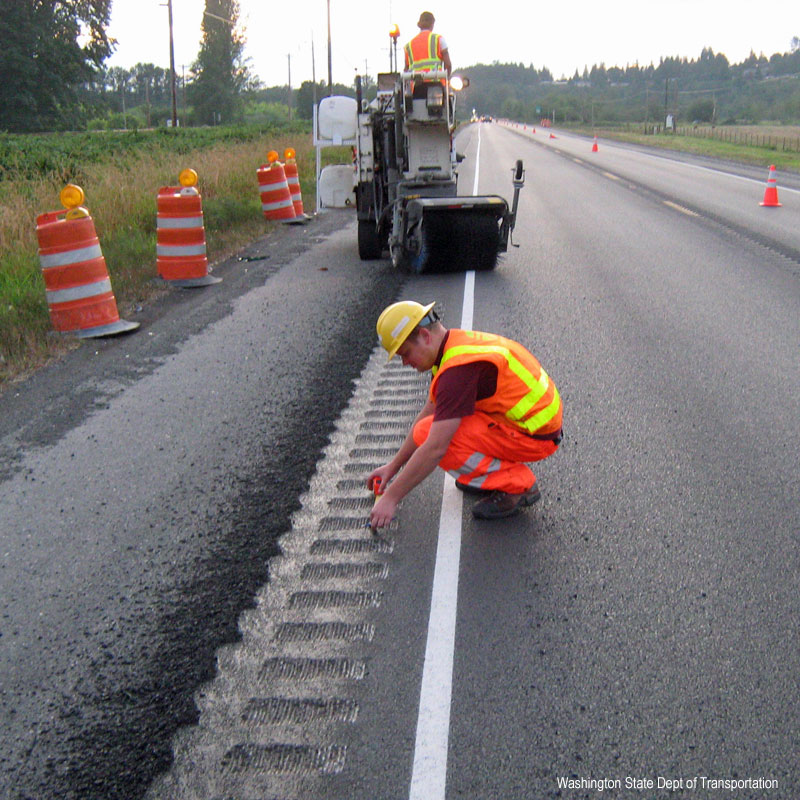Rumble strips are those fascinating grooves or raised patterns you see on the edges or center of many roads. They might seem like a simple design element, but they serve a crucial role in road safety. By alerting drivers when they stray from their lane or approach a potential hazard, these unassuming strips can prevent accidents and save lives. In this blog post, we're diving deep into what rumble strips are, their various types, and how they contribute to making our roadways safer for everyone.
Types of Rumble Strips

There are primarily three types of rumble strips, each designed to enhance road safety in unique ways. Let’s take a closer look at each type:
- Edge Line Rumble Strips: These are typically located along the outer edges of the roadway. They help to alert drivers who may be drifting out of their lane, especially at night or in poor weather conditions. By creating a distinct noise and vibration, edge line rumble strips act as a warning that encourages drivers to regain control.
- Centerline Rumble Strips: Found on two-way roads, centerline rumble strips serve a dual purpose. They help prevent head-on collisions by alerting drivers when they inadvertently cross over into oncoming traffic. The sound produced also reminds them of the correct lane, making them particularly effective in reducing accidents in rural areas.
- Transient Rumble Strips: These are used primarily in construction zones or temporary road detours. Unlike permanent types, transient rumble strips can be installed and removed as needed. They provide a clear warning to drivers about changing road conditions, ensuring that motorists stay alert to potential hazards.
In summary, understanding the different types of rumble strips can help you appreciate their role in road safety. Whether it's preventing lane departure or alerting drivers to roadwork ahead, these ingenious designs are all about creating safer driving environments. Next time you hit the road, keep an eye out for these vital safety features!
How Rumble Strips Function

Rumble strips are clever yet straightforward safety features that help prevent road accidents. So, how do these textured grooves work their magic? Let's break it down.
When you drive over a rumble strip—whether it's the kind on the shoulder or the centerline of the road—you'll feel a distinct vibration and hear a noise. This happens because rumble strips are made of grooves that are precisely engineered to create audible alert sounds when tires pass over them.
Here are the primary ways rumble strips function:
- Vibrational Alerts: As you drive over, the uneven surface vibrates through your vehicle, shaking the steering wheel and alerting you to potential danger.
- Audible Warnings: The design of the strips produces a loud rumbling sound, ensuring that distracted drivers notice their presence.
- Physical Indicators: Rumble strips can be a physical reminder of lane divisions or roadway edges, encouraging drivers to remain attentive and within their designated lanes.
In essence, these strips serve as tactile and auditory alerts to regain drivers' focus on the road, particularly in high-risk areas like sharp curves, construction zones, or points where the road narrows.
Benefits of Rumble Strips for Road Safety

Rumble strips provide a plethora of benefits aimed at enhancing road safety, making them an indispensable tool in preventing accidents. But what exactly makes them so effective?
Here’s a closer look at the key benefits:
| Benefit | Description |
|---|---|
| Accident Reduction | Studies show that areas with rumble strips have significantly lower accident rates, especially with head-on collisions and run-off-road crashes. |
| Cost-Effective | Implementing rumble strips is relatively low-cost compared to the potential costs associated with roadway accidents. They can save lives and expenses in the long run. |
| Increased Driver Awareness | These strips help keep drivers alert, reducing instances of drowsiness and distractions while driving. |
| Improved Nighttime Visibility | Rumble strips can be particularly beneficial at night when visibility is low, serving as a tactile guide for drivers navigating unfamiliar roads. |
In summary, the benefits of rumble strips go far beyond simple road design. They enhance safety, improve driver focus, and ultimately help save lives on the roads. Given their effectiveness, it's clear that incorporating rumble strips into our roadways is a wise and necessary choice for safer travels.
Implementation of Rumble Strips

When we're talking about the implementation of rumble strips, it's not just about slapping them down wherever we please. There’s a bit of art and science to it, really! Rumble strips need to be carefully planned and strategically placed to ensure they effectively promote road safety.
First off, let's break down some of the key steps involved in implementing rumble strips:
- Site Selection: Engineers conduct thorough assessments to determine the most appropriate locations for rumble strips, usually at places where driver fatigue or distraction is common.
- Design Specifications: There are various designs for rumble strips, including milled or cast designs, and each has different effectiveness. Decisions on width, depth, and spacing depend on various factors, including road conditions and speed limits.
- Installation Process: The installation may involve milling operations or surface-mounted options. Timing is key here, often planned during less busy traffic hours to minimize disruption.
- Testing and Evaluation: After installation, it’s crucial to monitor the effectiveness of the rumble strips. This can involve before-and-after studies on accident rates and driver behavior.
Moreover, it’s important to engage with local communities to ensure the strips are welcome additions. This could involve public meetings or informational campaigns, so drivers understand their purpose. In the end, effective implementation can create safe, alert, and more responsible driving environments.
Challenges and Considerations
While rumble strips are a fantastic tool for road safety, their implementation is not without challenges. Let’s dive into some of the key issues that can arise when think about adding these safety features to our roads.
- Noise Concerns: One challenge often raised by communities is the noise generated when vehicles drive over rumble strips, especially in residential areas. This can lead to complaints and pushback against their installation.
- Maintenance Costs: Like anything, rumble strips require upkeep. Weather conditions and road wear can affect their effectiveness, and this leads to ongoing costs for governments and local agencies.
- Effectiveness Varies by Location: What works in one area might not be effective in another. Factors such as local driver behavior, traffic volumes, and prevailing speeds can all impact how well rumble strips work.
- Potential for Driver Over-Reliance: There's a risk that drivers might start relying too heavily on rumble strips for safety, which could divert attention from other important aspects of driving.
In closing, while rumble strips offer significant benefits for enhancing road safety, it’s essential to approach their implementation with respect to these challenges. Open dialogues with communities, consistent evaluations, and adjustments based on local needs can go a long way in making these safety measures work effectively.
Understanding the Role of Rumble Strips in Road Safety
Rumble strips, often seen on highways and low-traffic roads, are made of a series of raised or grooved patterns on the road surface. Their primary purpose is to enhance road safety by alerting drivers to potential hazards. Here we explore their functionality and impact on road safety.
Rumble strips can be categorized into two main types:
- Centerline Rumble Strips: Placed along the center of two-way roads, these strips prevent head-on collisions by alerting drivers who drift out of their lanes.
- Edge Line Rumble Strips: Positioned along the outer edges of roadways, these are designed to warn drivers who veer off the road, especially on highways and rural roads.
The effectiveness of rumble strips in improving road safety is backed by several studies. Here are some key benefits:
| Benefit | Description |
|---|---|
| Accident Reduction | Rumble strips have been shown to reduce collisions, particularly at intersections and on rural roads. |
| Driver Alertness | The noise and vibrations from driving over rumble strips help maintain driver attention and responsiveness. |
| Cost-Effectiveness | Installing rumble strips is a low-cost roadway intervention compared to other safety measures like traffic signals. |
Moreover, rumble strips can be implemented in various areas, including school zones, as a reminder for drivers to reduce speed.
Conclusion: Rumble strips are an essential tool in the arsenal of road safety mechanisms, effectively reducing accidents and enhancing driver alertness at critical points on the roadway.
 admin
admin








